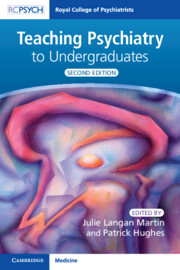Book contents
- Teaching Psychiatry to Undergraduates
- Teaching Psychiatry to Undergraduates
- Copyright page
- Contents
- Contributors
- Section 1 Principles of Medical Education
- Section 2 The Undergraduate Psychiatry Curriculum: Planning and Delivery
- Section 3 Clinical Placements in Psychiatry
- Section 4 Formal Teaching
- Chapter 4.1 How to Give a Lecture
- Chapter 4.2 How to Do Small Group Teaching
- Chapter 4.3 Case-Based Learning
- Chapter 4.4 Role Play and Experiential Learning
- Chapter 4.5 Simulation
- Chapter 4.6 Balint Groups for Medical Students
- Chapter 4.7 Teaching the Mental State Examination: An Example of Multimodal Teaching
- Section 5 Materials Development
- Section 6 Gathering feedback and quality improvement
- Section 7 Student Welfare
- Section 8 Developing as a medical educator
- Index
- References
Chapter 4.6 - Balint Groups for Medical Students
from Section 4 - Formal Teaching
Published online by Cambridge University Press: 12 October 2022
- Teaching Psychiatry to Undergraduates
- Teaching Psychiatry to Undergraduates
- Copyright page
- Contents
- Contributors
- Section 1 Principles of Medical Education
- Section 2 The Undergraduate Psychiatry Curriculum: Planning and Delivery
- Section 3 Clinical Placements in Psychiatry
- Section 4 Formal Teaching
- Chapter 4.1 How to Give a Lecture
- Chapter 4.2 How to Do Small Group Teaching
- Chapter 4.3 Case-Based Learning
- Chapter 4.4 Role Play and Experiential Learning
- Chapter 4.5 Simulation
- Chapter 4.6 Balint Groups for Medical Students
- Chapter 4.7 Teaching the Mental State Examination: An Example of Multimodal Teaching
- Section 5 Materials Development
- Section 6 Gathering feedback and quality improvement
- Section 7 Student Welfare
- Section 8 Developing as a medical educator
- Index
- References
Summary
There has been increasing emphasis on reflective practice throughout the NHS and in medical training, and this is cited as an essential skill by the GMC. There are many different models of reflective practice, but that used for medical students across the UK is the Balint model. Balint groups employ a particular structured approach to reflective practice and focus on the emotional aspects of the student/doctor–patient relationship. The structure of the groups and stance of the leadership provides a space to think about patients holistically and to explore the feelings that the patient evokes in the presenter and the group members. In medical student groups some modifications to traditional Balint groups may be made, with leaders taking a more active role in the discussion and accommodating wider concerns of the students beyond the student–patient relationship but which are of emotional relevance to them – for example their role as students in the treating team and their development as future doctors.
There is evidence that medical student participation in Balint groups can increase empathy, understanding of the doctor–patient relationship, and student communication skills.
- Type
- Chapter
- Information
- Teaching Psychiatry to Undergraduates , pp. 110 - 116Publisher: Cambridge University PressPrint publication year: 2022

